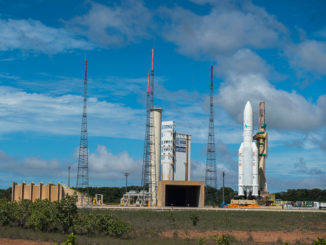STORY WRITTEN FOR CBS NEWS & USED WITH PERMISSION

Two test pilots and their instructor flew Virgin Galactic’s winged spaceplane out of the discernible atmosphere Friday for the second time in nine weeks, a successful sub-orbital flight that moves Richard Branson’s company one step closer to its goal of launching paying passengers and payloads on brief forays into the weightlessness of space.
Running two days late because of high winds, Virgin’s SpaceShipTwo rocketplane, also known as VSS Unity, was carried aloft from the Mojave Air & Space Port north of Los Angeles by a twin-fuselage carrier jet known as WhiteKnightTwo.
After the air and spacecraft were off the ground, Virgin Galactic revealed that chief pilot Dave Mackay and co-pilot Mike “Sooch” Masucci were joined by Beth Moses, the company’s chief astronaut instructor.
A few minutes later, around 11:50 a.m. EST (GMT-5), SpaceShipTwo was released from the carrier jet and a few moments later, Mackay and Masucci ignited the spacecraft’s hybrid rocket motor to begin a steep near-vertical climb out of the thick lower atmosphere.
It was the fifth supersonic flight of the futuristic-looking spaceplane and the 16th overall since a catastrophic 2014 in-flight breakup that destroyed an earlier version of the spacecraft and killed one of its two pilots. Friday’s flight was the company’s second featuring a long-duration rocket firing.

Branson, who was not on site for the test, said earlier he hopes testing will be complete in time for him to fly into space himself on July 20, the 50th anniversary of the Apollo 11 moon landing. But he said meeting an arbitrary target will not drive the test schedule and that commercial operations will not begin until all aspects of testing are complete.
“Having Beth fly in the cabin today, starting to ensure that our customer journey is as flawless as the spaceship itself, brings a huge sense of anticipation and excitement to all of us here who are looking forward to experiencing space for ourselves,” Branson said in a statement. “The next few months promise to be the most thrilling yet.”
Friday’s flight appeared to go off without a hitch as the pilots guided the vehicle out of the discernible atmosphere. The rocket motor shut down normally about a minute after ignition and the spacecraft coasted upward at a Virgin record 3.04 times the speed of sound to an altitude of 55.87 miles, or 295,007 feet.
For comparison, NASA pilot Joe Walker flew the air-launched X-15 rocketplane to an altitude of 67.1 miles on Aug. 22, 1963, the highest point ever achieved by the legendary aircraft, 17 miles above the 50-mile altitude the Air Force considers the “boundary” of space.
SpaceShipTwo made its first trip into space Dec. 13, reaching an altitude of 51.4 miles. The two pilots, Mark Stucky and C.J. Sturckow, a former space shuttle commander, were awarded commercial astronaut wings by the Federal Aviation Administration and their rocket motor was put on display at the Smithsonian’s National Air and Space Museum.
Mackay and Masucci flew a similar flight profile Friday, but SpaceShipTwo was rigged more like it will be or commercial flights and the motor fired slightly longer, pushing the vehicle to a higher altitude. And they had a passenger of sorts in Moses.
As the spacecraft arced over at the top of its trajectory, the crew experienced about five minutes of weightlessness as they enjoyed a view of Earth’s curved horizon and the deep black of space. Moses had time to unstrap and float about the cabin.
“Beth floated free to complete a number of cabin evaluation test points,” Virgin said in a post-flight statement. “The human validation of data previously collected via sensors, and the live testing of other physical elements of the cabin interior, are fundamental to the provision of a safe but enjoyable customer experience.”
Before plunging back to Earth, the pilots raised the vehicle’s twin tail booms to an angle of 60 degrees, a maneuver known as “feathering,” that increases atmospheric drag and eases aerodynamic stress.

“Beth, Sooch and I just enjoyed a pretty amazing flight which was beyond anything any of us has ever experienced,” Mackay said in a statement. “It was thrilling yet smooth and nicely controlled throughout with a view at the top, of the Earth from space, which exceeded all our expectations.
“For the three of us today this was the fulfillment of lifelong ambitions, but paradoxically is also just the beginning of an adventure which we can’t wait to share with thousands of others.”
The feather concept was the brainchild of legendary aircraft designer Burt Rutan. With financing from Microsoft co-founder Paul Allen, Rutan’s company at the time, Scaled Composites, carried out the first privately funded sub-orbital spaceflight in 2004 to win the $10 million Ansari X Prize.
Branson then arranged to use a scaled-up version of the design and founded Virgin Galactic, which eventually took over development and commercial flight operations.
During Friday’s flight, the feathering procedure worked normally and after rotating the tail booms back to their normal position, Mackay and Masucci flew a normal gliding approach to a runway landing back at the Mojave Air & Space Port.
“The team’s overriding priority is always to bring crew and spaceship home safely,” Virgin said in a pre-flight statement. “Whether we complete all our objectives during the next flight or not, we remain committed to completing the final stages of flight test as quickly, but more importantly as safely, as possible.”



